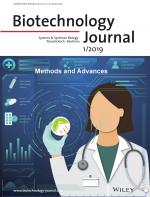Preparation and characterization of a cellulose affinity membrane for human immunoglobulin G (IgG) purification
- Citation:
- Barroso, T, Temtem M, Hussain A, Aguiar-Ricardo A, Roque ACA. 2010. Preparation and characterization of a cellulose affinity membrane for human immunoglobulin G (IgG) purification, feb. Journal of Membrane Science. 348:224–230., Number 1-2
Abstract:
This paper reports the design, preparation and characterization of cellulose affinity membranes for antibody purification using a new methodology. Cellulose membranes were prepared from polymer-ionic liquid solutions, namely 1-butyl-3-methylimidazolium chloride {([BMIM][Cl])}, by the water induced phase inversion process. After functionalization with a synthetic ligand 2-(3-aminophenol)-6-(4-amino-1-naphthol)-4-chloro-s-triazine (ligand 22/8), these were evaluated as affinity supports for human immunoglobulin G {(IgG).} Membranes were characterized in terms of morphology {(SEM)}, porosity (mercury porosimetry), hydrophilicity (contact angle measurement), transport properties (permeability) and mechanical performance {(DMA).} Membranes prepared with varying cellulose contents (5 and 10&\#xa0;wt.% cellulose in ionic liquid solutions) lead to films with different properties. The 10&\#xa0;wt.% cellulose membrane presented enhanced morphological and mechanical properties, however, the morphology of this membrane was significantly altered after ligand coupling. Adsorption isotherms for human {IgG} onto 10&\#xa0;wt.% matrix activated with ligand 22/8 were obtained. Preliminary results showed that the bovine serum albumin {(BSA)}, a model impurity, did not adsorb onto the membrane while up to 6&\#xa0;mg {IgG/g} was bound and 2&\#xa0;mg {IgG/g} recovered.
Notes:
n/a







